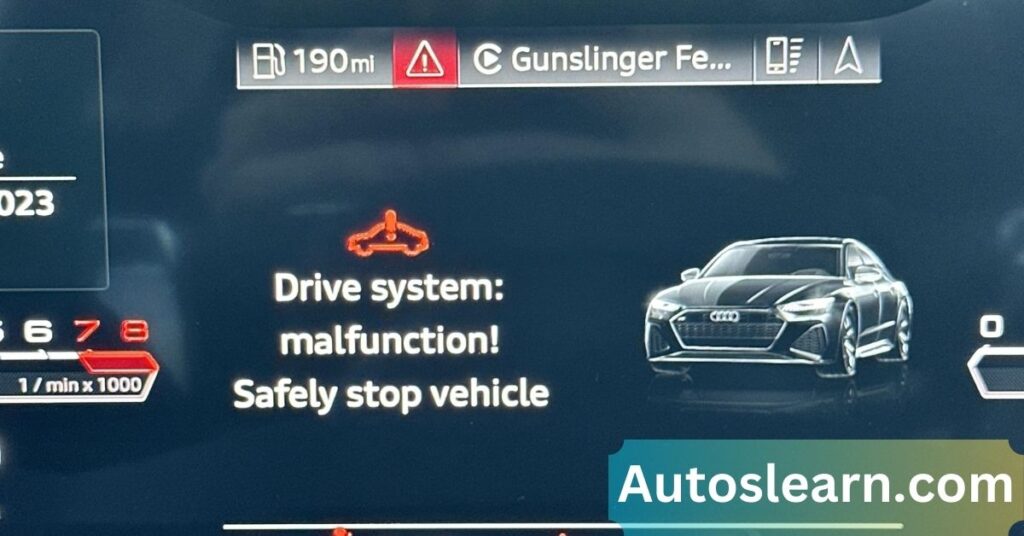Seeing a “Drive System Malfunction” warning on your Audi’s dashboard can be alarming. This message indicates an issue within the drivetrain, which includes critical components like the engine, transmission, and all-wheel-drive system.
It may lead to performance issues or even a complete breakdown if ignored. Identifying the cause early can help prevent costly repairs and ensure safe driving.
What is a Drive System in an Audi?
The drive system transfers power from the engine to the wheels, allowing movement. It consists of several key components:
- Engine: Generates power to propel the vehicle.
- Transmission: Adjusts power and torque for different speeds.
- Driveshafts: Transfers power to the wheels.
- Differentials: Distributes power evenly between the wheels.
- Electronic Control Systems: Monitors and regulates performance.
Any of these parts going bad could cause a warning on your dashboard.
Audi “Drive System Malfunction” is frequently caused by:
Several factors can trigger this error message. Some of the most typical explanations are as follows:
1. Faulty Sensors:
Modern Audis rely on sensors to monitor engine performance and drivetrain health. Malfunctioning sensors, such as the throttle position or oxygen sensor, can lead to incorrect signals and reduced performance.
2. Transmission Issues:
A failing transmission can cause the drive system to operate improperly. Problems may include:
- Slipping gears
- Harsh shifting
- Delayed acceleration
A warning that appears alongside rough shifting could indicate a transmission fault.
3. Battery or Alternator Problems:
Weak or failing batteries and alternators can lead to electronic failures. Since the drivetrain relies on electronic controls, low voltage can disrupt the system, triggering a malfunction warning.
4. Software/ECU (Engine Control Unit) Faults:
The ECU controls various vehicle functions, including drivetrain performance. A software glitch or outdated firmware can cause incorrect readings and trigger warnings.
5. Fuel or Air Intake Issues:
A clogged fuel injector, dirty air filter, or malfunctioning turbocharger can impact engine performance, leading to drive system errors. These issues can reduce power delivery to the wheels, affecting acceleration and efficiency.
6. All-Wheel Drive (Quattro) System Malfunctions:
Audi’s Quattro system ensures optimal power distribution between wheels. If the differential, transfer case, or wheel speed sensors fail, the system may not function correctly, triggering the warning.
7. Steering and Suspension Issues in Audi:
Steering and suspension problems can affect how your Audi handles and feels on the road. Common signs include:
- Steering Vibrations: Shaking or instability when turning the wheel.
- Difficulty Turning: Increased effort needed to steer.
- Pulling to One Side: The car drifts without input.
These issues strain the drive system and may contribute to a drive system malfunction warning. Regular maintenance, including wheel alignment and suspension checks, helps prevent further damage and keeps your Audi running smoothly.
How to Resolve Audi “Drive System Malfunction”:

If your Audi displays this warning, follow these steps to diagnose and fix the issue:
- Restart the Car: After turning off the engine, restart after a few minutes of waiting. Temporary electronic glitches may clear after a reset.
- Scan for Error Codes: Look for diagnostic trouble codes (DTCs) with an OBD-II scanner. These codes can determine the specific issue.
- Check the Battery and Alternator: Ensure the battery voltage is above 12.6V when off and around 14V when running. If it’s weak, replace it.
- Inspect Transmission Fluid: Low or filthy transmission fluid might cause shifting issues. Verify the fluid’s condition and level and replace it if necessary.
- Clean or Replace Sensors: Malfunctioning sensors, such as the mass airflow or oxygen sensor, should be cleaned or replaced if faulty.
- Update ECU Software: If the issue stems from a software bug, updating the ECU at an Audi dealership may resolve the problem.
- Check for Recalls or Technical Service Bulletins (TSBs): Audi may have issued recalls or TSBs related to drivetrain issues. Check with an authorized dealer for any updates.
Preventing Drive System Malfunctions:
Regular maintenance can help prevent drive system issues. Here are some key steps:
- Follow Scheduled Maintenance: Refer to your Audi’s owner manual and follow the recommended service intervals.
- Monitor Fluid Levels: Ensure engine oil, transmission fluid, and coolant are at proper levels and changed as recommended.
- Keep Software Updated: Check with an Audi dealer for the latest ECU updates to fix potential software-related issues.
- Drive Responsibly: Avoid aggressive driving habits that strain the drivetrain unnecessarily, such as sudden acceleration and harsh braking.
Real-Life Cases of Audi Drive System Malfunction:
Understanding real-world issues helps highlight common Audi drive system malfunctions and their solutions. Here are two examples:
Case 1-Ignition Coil Failure (2015 Audi A4):
A driver on a long trip suddenly sees a drive system malfunction warning. The car loses power, and the engine makes a humming sound. An OBD-II scan shows a P0300 error code, pointing to a cylinder misfire. The cause? Worn ignition coils. Replacing them restores performance. Regular maintenance could have prevented the issue.
Case 2-Differential Wear (2013 Audi Q5):
While cruising the highway, an Audi Q5 driver experiences a sudden power drop and hears a grinding noise underneath the car. A technician finds that the differential is worn out due to lack of maintenance. Replacing the part and following a proper service schedule prevents further problems.
Both cases show the importance of early diagnosis and routine checks to keep Audi’s driving system running smoothly.
Diagnosing a Drive System Malfunction in Audi:

Identifying a drive system malfunction in an Audi starts with the right tools. OBD-II scanners can read diagnostic trouble codes (DTCs) stored in the vehicle’s system, helping pinpoint the issue.
For more detailed analysis, Audi-specific tools like VAG-COM offer more profound insights. Along with scanning, check fluid levels, leaks, and unusual noises during a test drive. A physical inspection of key components can reveal wear or damage.
Always refer to the service manual for correct troubleshooting steps, ensuring accurate diagnosis and proper maintenance.
Regular Maintenance-Preventing Drive System Issues:
Keeping your Audi’s drive system in good shape starts with regular maintenance. Routine engine checks, transmission servicing, and inspections of driveshafts and differentials help prevent issues before they become significant problems.
Diagnostic tools like OBD-II scanners or VAG-COM allow for the early detection of system errors. Catching minor issues early can prevent costly repairs and keep your vehicle running smoothly. Consistent maintenance is the best way to avoid a drive system malfunction warning.
Safety Precautions to Prevent Further Damage:
Acting quickly if a drive system malfunction warning appears can help prevent more significant issues. Pull over safely and turn off the engine to avoid further strain on the vehicle.
Before attempting any fixes, take time to understand the problem. Misreading error codes or making incorrect adjustments could lead to additional damage. If unsure, seek professional help to ensure the issue is handled correctly.
Tips to Keep Your Audi Drive System Running Smoothly:

Taking care of your Audi’s drive system requires more than fixing issues as they arise. Regular maintenance ensures smooth performance and prevents costly repairs.
1. Check Essential Fluids:
Fluids play a crucial role in lubricating and cooling components. Regularly check:
- Engine oil – Prevents excessive friction.
- Transmission fluid – Ensures smooth gear shifts.
- Power steering fluid – Maintains responsive steering.
- Brake fluid – Supports safe braking.
- Coolant – Prevents overheating.
2. Maintain Tire Health:
Proper tyre pressure reduces strain on the drivetrain. Regularly rotating tyres promote even wear, creating a balanced and stable drive system.
3. Schedule Engine Tune-Ups:
A well-maintained engine keeps the drive system efficient. Watch for delayed acceleration or rough idling, as these may signal the need for a tune-up.
4. Keep Software Updated:
Modern Audis rely on electronic control systems. Updating your car’s software can fix bugs, improve performance, and prevent unnecessary drive system malfunction warnings.
5. Get Professional Inspections:
Routine diagnostics can detect hidden issues before they worsen, even if no warning lights appear. Early detection reduces repair costs and extends the life of your Audi’s drive system.
By following these preventive steps, you can avoid unexpected breakdowns and enjoy a reliable driving experience.
When to Seek Professional Help:
If the warning light persists after basic troubleshooting, take your Audi to a certified mechanic or dealership. Delaying repairs could lead to more severe drivetrain damage and higher repair costs.
What Is the Malfunction Indicator Lamp (MIL) in an Audi?
The Malfunction Indicator Lamp (MIL) is part of Audi’s On-Board Diagnostic (OBD-II) system. It turns on when you start the ignition and should switch off once the engine runs smoothly.
If the MIL stays on or flashes, it signals a possible engine issue or emissions system fault. Ignoring it could lead to performance problems or even long-term damage. Checking for diagnostic trouble codes (DTCs) with an OBD-II scanner can help identify the exact cause.
Can You Drive with the Malfunction Indicator Light On?
Driving with the Malfunction Indicator Light (MIL) on isn’t recommended. It can signal engine problems, reduced fuel efficiency, or potential damage to key components. The car may sometimes enter limp mode, restricting performance to prevent further harm.
If the light stays on, schedule a diagnostic check as soon as possible. Ignoring the issue could lead to expensive repairs or breakdowns.
Frequently Asked Questions:
Q1. What is a drive system malfunction in an Audi?
A drive system malfunction warning appears on the dashboard when the engine experiences instability. It signals potential issues affecting performance or safety.
Q2. What does an electrical system malfunction mean on an Audi?
This warning usually points to problems with the battery or charging system. If left unchecked, it may lead to starting issues or system failures.
Q3. What does an Audi safety system malfunction mean?
This alert indicates a problem with safety features, such as airbags. A malfunction could affect airbag deployment in an accident.
Q4. How serious is a drivetrain malfunction?
A drivetrain malfunction can impact vehicle control and performance. Driving with this warning may cause further damage and reduce safety.
Conclusion:
The “Drive System Malfunction” warning in an Audi can indicate anything from minor sensor issues to major drivetrain faults. Understanding the possible causes, performing basic troubleshooting, and keeping up with regular maintenance can help keep your vehicle running smoothly. If the issue persists, a professional diagnosis is recommended to prevent further damage and ensure safe driving.



